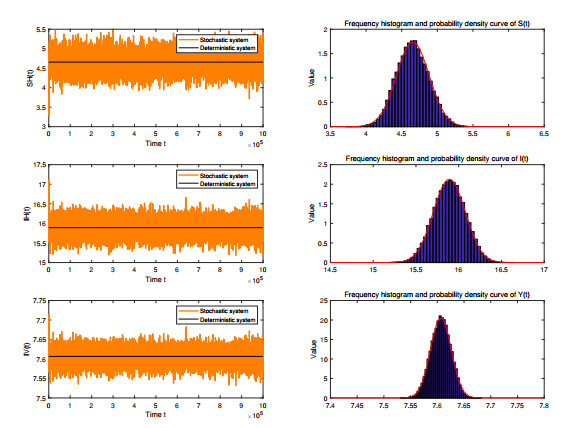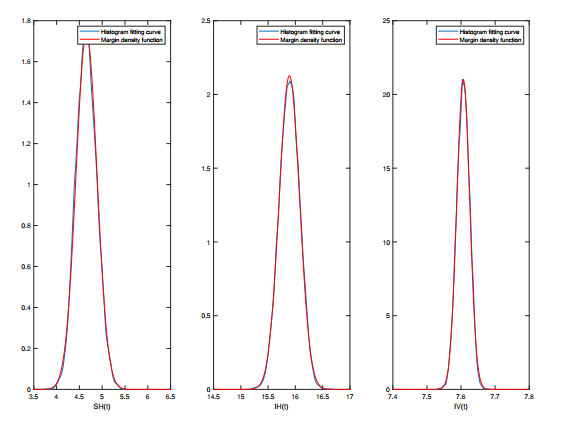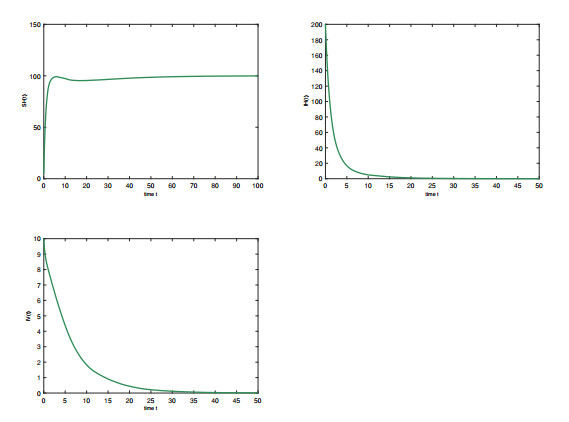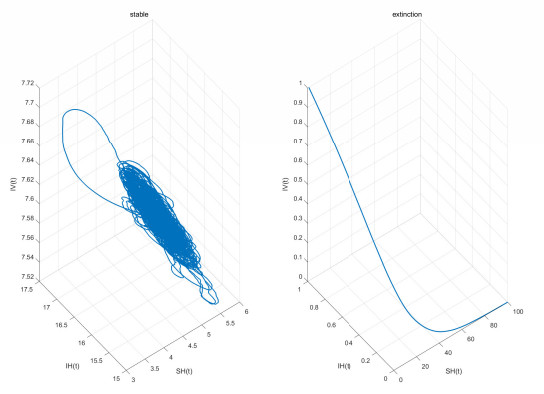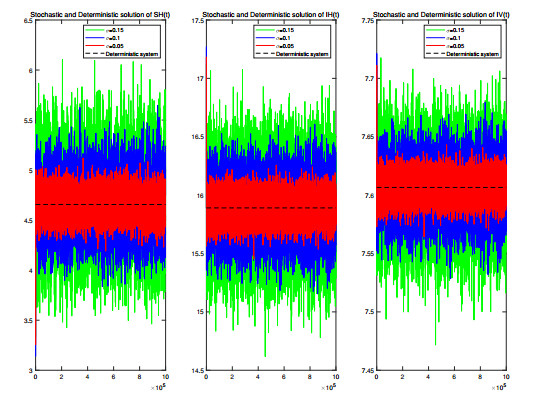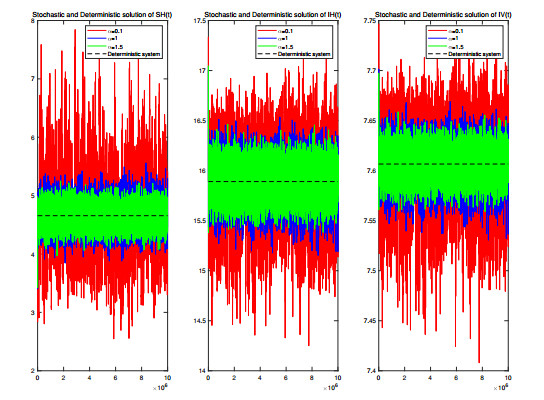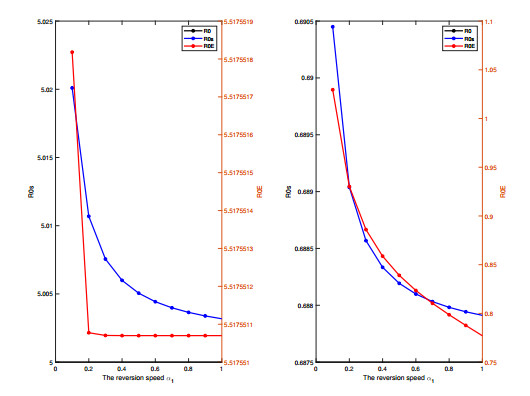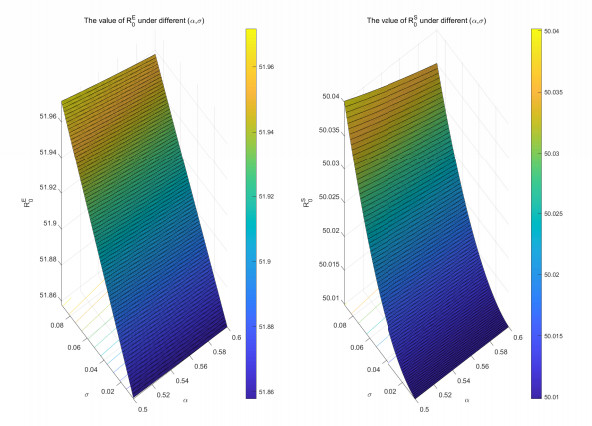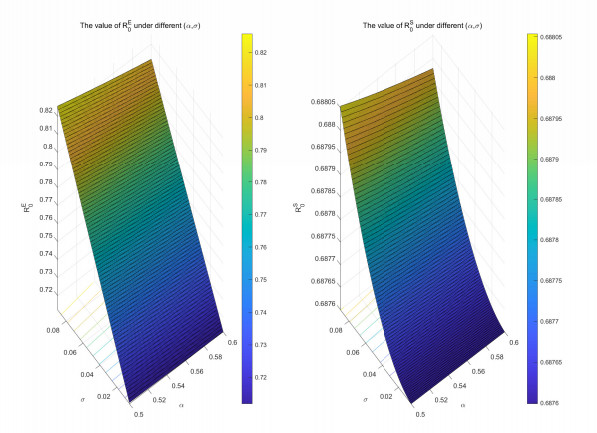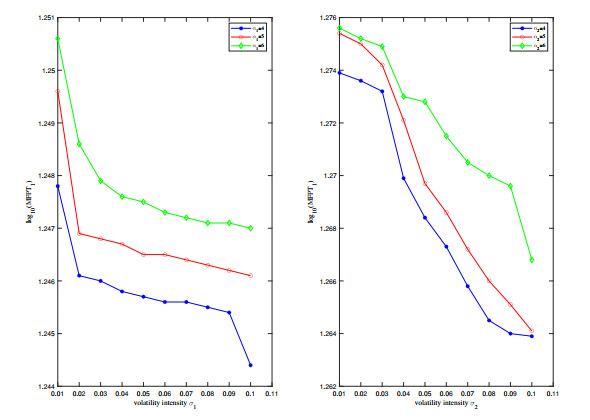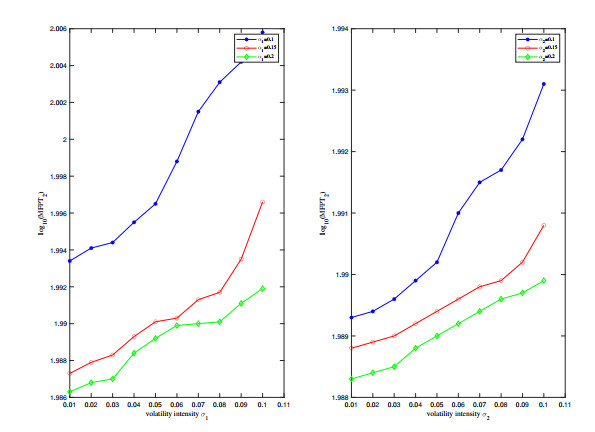1.
Introduction
Mosquito-borne infectious diseases, a common type of vector-borne infections diseases, are primarily caused by pathogens, which are transmitted from mosquitoes to humans or other animals [1]. Mosquitoes are one of the most widely distributed vectors in the world, transmitting a variety of parasites and viruses. While the vector organisms may not develop the disease themselves, they serve as a means for the pathogen to spread among hosts. With mosquitoes found in various locations from tropical to temperate zones, mosquito-borne infections have a wide and diverse geographic distribution [2]. Diseases such as malaria, lymphatic filariasis, West Nile Virus, Zika virus, and dengue fever are commonly transmitted by mosquitoes, with no specific vaccine or medication available for treatment. These diseases pose a significant threat to human health and socio-economic development worldwide.
Malaria is an infectious disease caused by a protozoan parasite that is mainly transmitted to humans through the bite of a mosquito [3]. The disease is widespread in tropical and subtropical regions, particularly in poorer areas of Africa, Asia, and Latin America. Globally, malaria remains a major public health problem, resulting in millions of infections and hundreds of thousands of deaths annually. Apart from malaria, as the classic mosquito-borne infectious disease, dengue fever also attracts considerable attention. Dengue fever is a serious infectious disease caused by the dengue virus, primarily transmitted to humans by the Aedes aegypti mosquito, but also through blood transfusion, organ transplantation, and vertical transmission [4]. In addition, both yellow fever and West Nile disease are also caused by mosquitoes carrying the corresponding viral infections [5,6]. Yellow fever is a rare disease among U.S. travelers. Conversely, West Nile virus is the primary mosquito-borne disease in the continental U.S., commonly transmitted through the bite of an infected mosquito.
Research on mosquito-borne diseases has proliferated [7,8,9,10]. Mathematical models have been increasingly used for experimental and observational studies of different biological phenomena, and a wide range of techniques and applications have been developed to study epidemic diseases. For example, Newton and Reiter [8] developed a deterministic Susceptibility, Exposure, Infection, Resistance, and Removal (SEIR) model of dengue transmission to explore the behavior of epidemics and realistically reproduce epidemic transmission in immunologically unmade populations. Moreover, Pandey et al. [9] proposed a Caputo fractional order derivative mathematical model of dengue disease to study the transmission dynamics of the disease and to make reliable conclusions about the behavior of dengue epidemics. In addition, in order to investigate the effect of the vector on the dynamics of the disease, Shi and Zhao et al. [10] proposed a differential system with saturated incidence to model a vector-borne disease
the biological significance of the model (1.1) parameters are shown in Table 1. In this model, there are two populations, namely mosquito vector population and human host population. The mosquito vector population is divided into two categories, SV and IV, and N=SV+IV, while human host population is divided into three categories, SH,IH and RH. According to [10], it is reasonable to assume that the total number of human K=SH+IH+RH is a positive constant.
Obviously, we can get that there always exists a compact positively invariant set for model (1.1) as follows
The incidence rate has various forms and plays an important role in the study of epidemic dynamics. In addition to the saturated incidence used in model (1.1) of this paper, other forms of the incidence rate have been widely used. For example, Chong, Tchuenche, and Smith [11] studied a mathematical model of avian influenza with half-saturated incidence rate SbIbHb+Ib, SHIaHa+Ia and ShImHm+Im. In addition, Li et al. [12] also carried out numerical analysis of friteral order pine wilt disease model with bilinear incidence rate ShIv and IhSv. In order to make the model (1.1) have wider research significance and apply to more infectious diseases, we consider replacing the saturated incidence rate with the general incidence rate ϕ1(IV), ϕ2(IH) and ϕ3(IH), and then give the epidemic model with the general incidence as follows
Furthermore, the incidence rate in model (1.3) are assumed to meet the following conditions
(A1) ϕ1(0)=ϕ2(0)=ϕ3(0)=0,
(A2) ϕ′1(IV)≥0,ϕ′2(IH)≥0,ϕ′3(IH)≥0,∀ IV,IH≥0,
(A3) 0≤(IVϕ1(IV))′≤m0,0≤(IHϕ2(IH))′≤m0,0≤(IHϕ3(IH))′≤m0, where m0 is a positive constant.
By looking at the model (1.3), the following equation is valid, dNdt=Λ−mN, that indicates, N(t)→Λm as t→∞. Note that SH+IH+RH=K, SV+IV=Λm, this means that RH=K−SH−IH, SV=Λm−IV, let ω=d+μ+γ, thus the host population and pathogen population system are equivalent to the following system
Noise is ubiquitous in real life, and the spread of infectious diseases will inevitably be affected by the environment and other external factors. With the unpredictable environment, some key parameters in the infectious disease model are inevitably affected by external environmental factors. Therefore, in order to more accurately describe the transmission process, we use a stochastic model to describe and predict the epidemic trend of diseases. For the perturbation term of the parameter, two methods are commonly used, including linear function of Gaussian noise and mean-reverting stochastic process [13,14,15,16,17]. For Gaussian noise, when the time interval is very small, the variance of the parameter will become infinite, indicating that the parameter has changed greatly in a short time, which is unreasonable [18]. So we mainly consider the mean-reverting Ornstein–Uhlenbeck process. Let βi(i=1,2) take the following form
where αi represent the speed of reversal and σi represent the intensity of fluctuation. Solve the Eq (1.5), we can get
where βi(0) is the initial value of βi(t). For arbitrary initial value βi(0), βi(t) follows a Gaussian distribution βi(t)∼N(¯βi,σ2i2αi)(t→∞). Furthermore, setting βi(0)=¯βi, then the average value of βi(t) satisfies
it is known that the mathematical expectation and variance of βi(t) are ¯βi and σ2it3+O(t2), respectively, where O(t2) is the higher order infinitesimal of t2. Obviously, the variance becomes zero instead of infinity as t→0. This shows the universality of the Ornstein–Uhlenbeck process. Moreover, in order to ensure the positivity of the parameter values after adding the perturbation, the log-normal Ornstein-Uhlenbeck process for the noise perturbation to the transmission rates β1 and β2 of the system (1.4) is used, then following stochastic model is obtained
In this paper, we extend the saturated incidence rate of model (1.1) to the general incidence ϕ1(IV), ϕ2(IH) and ϕ3(IH) to obtain models (1.3) and (1.4), and investigate the global asymptotic stability of the equilibrium point of model (1.3). Furthermore, we choose to modify the parameter β1 and β2 to satisfy the log-normal Ornstein-Uhlenbeck process to obtain the stochastic model (1.6), and study its stationary distribution, exponential extinction, probability density function near the quasi-equilibrium point and other dynamic properties.
The rest of this article is organized as follows. In Section 2, some necessary mathematical symbols and lemmas are introduced. In Section 3, some conclusions of deterministic model (1.3) are obtained and the global stability of equilibrium point in this model is proved. In Section 4, we obtain some theoretical results for the stochastic system (1.6) where we prove the existence of a unique global positive solution for the stochastic system (1.6). In addition, through the ergodic properties of parameters βi(t),i=1,2 and the construction of a series of suitable Lyapunov functions, sufficient criterion for the existence of stationary distribution is obtained, which indicates that the disease in the system will persist. Next, we have sufficient conditions for the disease to go extinct. Further, we solve the corresponding matrix equation to obtain an expression for the probability density function near the quasi-local equilibrium point of the stationary distribution. Next, in Section 5, some theoretical results are verified by several numerical simulations. Finally, several conclusions are given in Section 6.
2.
Preliminaries
To make it easier to understand, denote Rn+={(y1,y2,...yn)∈Rn|yj>0,1≤j≤n}. In represents the n-dimensional unit matrix. IA denotes the indicator function of set A, and it means that when x∈A,IA=1, otherwise, IA=0. If A is a matrix or vector, then AT stands for its inverse matrix, and A−1 stands for its inverse matrix.
Lemma 2.1. (Itˆo's formula [19]) Consider the n-dimensional stochastic differential equation
where B(t)=(B1(t),B2(t),...,Bn(t)) and it represents n-dimensional Brownian motion defined on a complete probability space, let L act on a function V∈C2,1(Rn×R+;R), then we have
where
it represents the differential operator, and
Lemma 2.2. (Ma et al. [20]) Letting ϕ(λ)=λn+a1λn−1+a2λn−2+⋯+an−1λ+an is the characteristic polynomial of the square matrix A, the matrix A is called a Hurwitz matrix if and only if all characteristic roots of A are negative real parts, that is equivalent to the following conditions being true
k=1,2,⋯,n, among them j>n, replenishing definition aj=0.
Lemma 2.3. ([21]) For five-dimension algebraic equation G20+LΘ+ΘLT=0, where Θ is a symmetric matrix, G0=diag(1,0,0,0,0) and
If l1>0,l2>0,l3>0,l4>0 and l1l2l3−l23−l21l4>0, then the symmetric matrix Θ is a positive semi-definite matrix. Thus, we have
where l=2(l4l21−l1l2l3+l23).
Lemma 2.4. ([22,23]) For n-dimension stochastic process (1.6), X(t)∈Rn and its initial value X(0)∈Rn, if there is a bounded closed domain U in Rn with a regular boundary and
in which P(τ,X(0),U) represents the transition probability of X(t), then X(t) has an invariant probability measure on Rn, then it admits at least one stationary distribution.
3.
Theoretical results for model (1.3)
In this section, we focus on the local stability of the equilibrium point of the deterministic model (1.3). Initially, we verify the existence and uniqueness of equilibria model (1.3). We can calculate the basic reproduction number of the deterministic model (1.3) by the next generation method [24], define
therefore, the next generation matrix is
then, the basic reproduction number for system (1.3) is obtained
Based on the key value of the basic reproduction number R0, the conditions for the existence of local equilibrium point for the model (1.3) can be found.
Theorem 3.1. The disease-free equilibrium E0 of model (1.3) is E0=(SH0, 0, 0, SV0, 0)=(K, 0, 0, Λm, 0) which always exists. If R0>1, there is a unique local equilibrium E∗=(S∗H, I∗H, R∗H, S∗V, I∗V).
After finding the conditions for the existence of the equilibrium point of model (1.3), next we verify that the global stability of equilibria.
Theorem 3.2. (i) If R0<1, the disease-free equilibrium point E0 is globally asymptotically stable. If R0>1, E0 is unstable. (ii) If R0>1, the endemic equilibrium point E∗ is globally asymptotically stable.
Remark 3.2 The global stability of E0 in this theorem can be referred to the method in the literature [10]. By constructing a series of suitable Lyapunov functions, we prove the global stability of E∗.
4.
Theoretical results for model (1.6)
Initially, we verify that the stochastic model (1.6) has a unique global positive solution. This provides preparation for the dynamic behavior of the model. For model (1.6), it is easy to see that
is the positive invariant set, and the subsequent research will be discussed in Γ.
Theorem 4.1. For any initial value (SH(0),IH(0),IV(0),β1(0),β2(0))∈Γ, there exists a unique solution (SH(t),IH(t),IV(t),β1(t),β2(t)) of system (1.6) and the solution will remain in Γ with probability one (a.s.).
The stationary distribution of stochastic model (1.6) plays a key role in regulating the dynamics of disease and analyzing the sustainable development of disease. Next, sufficient conditions for the existence of stationary distribution will be obtained. We define
where
Theorem 4.2. If Rs0>1, then stochastic system (1.6) has a stationary distribution.
Remark 4.2 The Theorem 4.2 is proved by constructing the Lyapunov functions. It is observed that when Rs0>1, a stationary distribution exists and the disease will be endemic for a long period of time.
Furthermore, disease propagation and extinction are two major areas of research in stochastic system dynamics. After establishing the conditions under which a disease reaches a stable state, it is also essential to understand the conditions under which the disease becomes extinct. In addition, we discuss the sufficient condition for disease extinction in the model (1.6), define
Theorem 4.3. If RE0<1, then the disease of the system (1.6) will become exponentially extinct with probability 1.
Remark 4.3 Theorem 4.3 gives the sufficient condition for the exponential extinction of diseases IH, IV. From the expressions of Rs0 and RE0, the relationships Rs0≥R0 and RE0≥R0 are deduced, and the equal sign holds if and only if σ1=σ2=0.
Additionally, the density function of a continuous distribution is essential to understanding a stochastic system, making the precise determination of its expression a crucial challenge. Through the matrix analysis method, we have successfully derived the expression for the probability density function in the vicinity of the equilibrium point for model (1.6). Linearize the model (1.6) before calculate the probability density function. Define a quasi-endemic equilibrium point P∗=(S∗H,I∗H,I∗V,logβ∗1,logβ∗2), it satisfies
Let (z1,z2,z3,x1,x2)T=(SH−S∗H,IH−I∗H,IV−I∗V,logβ1−logβ∗1,logβ2−logβ∗2)T, then system (4.1) can be linearized around P∗ as follows
where a11=μ+¯β1ϕ1(I∗V)+¯β2ϕ2(I∗H), a12=¯β2ϕ′2(I∗H)S∗H−d, a13=¯β1ϕ′1(I∗V)S∗H, a14=¯β1ϕ1(I∗V)S∗H, a15=¯β2ϕ2(I∗H)S∗H, a21=¯β1ϕ1(I∗V)+¯β2ϕ2(I∗H), a22=ω−¯β2ϕ′2(I∗H)S∗H, a32=β3ϕ′3(I∗H)(Λm−I∗V), a33=β3ϕ3(I∗H)+m, a44=α1, a55=α2. Apparently, aij>0.
By denoting
Then system (4.1) can be expressed as
then, the solution of (4.3) can be calculated as
since ∫t0eA(t−s)GdB(t) obeys a normal distribution N(0,ˆΣ(t)) at time t, where ˆΣ(t)=∫t0eA(t−s)GGTeAT(t−s)ds, then, we can get X(t)∼N(eAtX(0),ˆΣ(t)).
First, we need to verify that matrix A is Hurwitz matrix [25], the characteristic polynomial of A can be obtained as follows
Obviously there are λ1=−a44,λ2=−a55, other characteristic roots can also be found with negative real part according to Section 3. Therefore, matrix A is a Hurwitz matrix by Lemma 2.2. According to the stability theory of zero solution to the general linear equation [20], we have
Based on the solution of Gardiner [26], it follows
Second, we will solve the Eq (4.4) to get the exact expression of probability density function near the quasi-endemic equilibrium.
Theorem 4.4. For any initial value (SH(0),IH(0),IV(0),β1(0),β2(0))∈Γ, if R0>1 and m−μ+β3ϕ3(I∗H)>0, then the stationary distribution of stochastic system (1.6) near the P∗ approximately admits a normal probability density function as follows
The exact expression of covariance matrix Σ is shown in the proof.
Remark 4.4 In Theorem 4.4, by defining the quasi-endemic equilibrium P∗, we derive an exact expression of probability density function of the stationary distribution around a quasi-positive equilibrium P∗.
5.
Numerical simulations and conclusions
In order to illustrate the above theoretical results, we perform several numerical simulations in this section. Consider bilinear incidence rate ϕ1(IV)=IV, ϕ2(IH)=IH, ϕ3(IH)=IH, letting xi(t)=logβi(t)−logˉβi,i=1,2, then according to the method in [27], the following is the corresponding discretized equation for the system (1.6)
let ξi,j be random variables that follow a Gaussian distribution N(0,1) for i=1,2 and j=1,2,...,n. The time interval is denoted by Δt>0. The values (SjH,IjH,IjV,xj1,xj2) correspond to the j-th iteration of the discretization equation.
5.1. Simulations for stationary distirbution and extinction
First and foremost, taking into consideration the importance of parameter selection, rationality, and the visual effectiveness of theoretical results, we choose the following appropriate parameters, referring to [10,28,29], and denoted them as Number 1
after calculation, we can get m−μ+β3I∗H=2.0391>0 and the indexes of deterministic system and stochastic system can be obtained respectively, as shown below
which satisfies the condition in Theorem 4.2. More importantly, we can calculate the quasi-endemic equilibrium and the covariance matrix Σ, which have the following forms
Therefore, we can get that the solution (SH(t),IH(t),IV(t),β1(t),β2(t)) obeys the normal density function
The marginal density functions are as follows
Using the above parameters, we can get trajectories of SH(t), IH(t) and IV(t) respectively, which are present in Figure 1. It is used to represent the variation of the solution (SH(t),IH(t),IV(t)) in the deterministic model (1.4) and the stochastic model (1.6). Frequency histograms and marginal density function curves for SH(t),IH(t) and IV(t) are also given in the right column of the Figure 1.
In addition, the frequency fitted density functions and the marginal density functions for SH(t),IH(t) and IV(t) are given in Figure 2, respectively, which are highly consistent. Therefore, we deduce that the solutions (SH(t),IH(t),IV(t)) have a smooth distribution and their density functions follow a normal distribution. As we can see, the disease eventually spreads, which is consistent with Theorem 4.2.
On the other hand, we select that a part of parameters are shown below, and the remaining parameters are consistent with Number 1, ¯β1=0.015,¯β2=0.001,β3=0.015. These are denoted as Number 2. The crucial value RE0 takes the form
which satisfies the condition in Theorem 4.3. Figure 3 represents the trajectory of the solution (SH(t),IH(t),IV(t)), and it is clearly visible that the eventual trend of the disease is towards extinction.
Further, by choosing the parameters in Numbers 1 and 2, respectively, the left panel in Figure 4 satisfies the condition Rs0>1 and the right panel satisfies RE0<1. It can be seen that the disease exhibits a trend towards stabilization and extinction as conditions Theorems 4.2 and 4.3 are satisfied, respectively.
5.2. The effect of noise on stochastic epidemic model
Now, we study the effect of perturbations for a mosquito-borne epidemic model. Assuming that all parameters take the values in Number 1, we choose different reversion speed α and volatility intensity σ to plot the graphs, respectively. Taking α1=α2=0.8 and different volatility intensity as shown in the Figure 5, the icons are red line σi=0.05, blue line σi=0.1 and green line σi=0.15, i=1,2, the trends of the solution (SH(t),IH(t),IV(t)) of the stochastic model (1.6) are represented by the figure. It shows that the fluctuation decrease as the volatility intensity decreases. Then, we set the volatility intensity σ1=σ2=0.1, the reversion speed αi=0.1 as shown by the red line in the figure, the blue line shows αi=1.0, and similarly, the green line indicates αi=1.5, i=1,2, then the same insightful changes in Figure 6 indicate that the fluctuation decreases with the increase of the reversion speed.
Further, we make the rest of the parameter assumptions consistent with Numbers 1 and 2, respectively, except for the the volatility intensity and reversion speed. Figures 7 and 8 depict the trends of R0,Rs0, and RE0 under different volatility intensity and different reversion speed, respectively, and the range of the two variables we choose is [0,1]. Combining the information in the two figures, it can be concluded that higher reversion speed and lower volatility intensity can make RE0 and Rs0 smaller.
Next, we continue to discuss the effects of reversion speed α and volatility intensity σ on Rs0 and RE0 and their magnitude relationships under different conditions.
(i) Assuming that α1, σ1 are the variables, and the other parameters are consistent with Number 1, The Figure 9 shows the three-dimensional chromatograms of Rs0 and RE0, which are consistent with the results of Figures 7 and 8, where Rs0 increases with increasing σ1, and decreases with increasing α1. This indicates that the disease stabilizes as the reversion speed decreases or volatility intensity increases. In addition, it can be seen that both Rs0 and RE0 are greater than 1 and RE0 is greater than Rs0 in the range where α1 belongs to [0.5,0.6] and σ1 belongs to [0.005,0.09];
(ii) Conditionally the same as in (i), we set the other parameters are consistent with Number 2, it is noted that RE0 increases with the increase of σ1 and decreases with the increase of α1 in Figure 10, implying that the diseases in the stochastic model (1.6) tend to become extinct when the volatility intensity decreases. Moreover, in the parameter range of the plot, both Rs0 and RE0 are less than 1, and RE0 is greater than Rs0.
5.3. The mean first passage time
Next, we will discuss the mean first passage time, the moment a stochastic process first transitions from one state to another is termed the first passage time (FPT) [30]. The mean first passage time (MFPT) is then defined as the average of these first passage times [31]. Starting with an initial value of (SH(0),IH(0),IV(0)), we aim to examine the time it takes for the system to evolve from this initial state to either a stationary state (MFPT1) or to an extinction state (MFPT2).
Then we define τ1 as the FPT from the initial state to the persistent state, and τ2 as the FPT from the initial state to the extinct state
Then we have
Using Monte Carlo numerical simulation method, if SH(nΔt)<S∗H, IH(nΔt)>I∗H, IV(nΔt)>I∗V, then τ1=nΔt, assuming that the number of simulations is N, then
Similarly, if IH0<0.0001 and IV0<0.0001, then τ2=mΔt and
Here, we set N = 2000, σi and αi, i=1,2 are random variables. Figures 11 and 12 depict the relationship between MFPT1 and MFPT2 and the speed of reversion αi and the volatility intensity σi, i=1,2 in stochastic system (1.6) with the bilinear incidence rate, respectively. Figure 11 reveals the values of MFPT1 with N=2000,σi∈[0.01,0.1] and αi=4,5,6, i=1,2, respectively. It shows that MFPT1 decreases with decreasing reversion speed αi or increasing voltility intensity σi, implying that the disease is much easier to arrive the stable state. Similarly, Figure 12 shows the trend of MFPT2 at N=2000, σi∈[0.01,0.1] and αi=0.1,0.15,0.2. Through the figure it can be noted that MFPT2 increases with αi decrease and σi increase.
6.
Conclusions
We mainly develop a stochastic model, coupled with the general incidence rate and Ornstein-Uhlenbeck process, to study the dynamic of infectious disease spread, which includes the stationary distribution and probability density function. In view of our analysis, we can draw the following conclusions
(i) For the deterministic epidemic model, two equilibria and the basic reproduction number R0 are obtained, and their global asymptotic stability are deduced. Specificaly, the endemic equilibrium is globally asymptotically stable if R0>1, and the disease free equilibrium is globally asymptotically stable if R0<1.
(ii) Considering that the spread of infectious disease is inevitably affected by environmental perturbations, we propose a stochastic model with general incidence and the Ornstein-Uhlenbeck process. By constructing a series of appropriate Lyapunov functions, the stationary distribution of model (1.6) is derived and we establish the sufficient criterion for the existence of the extinction. Specifically, the innovation of this paper is that we obtain a precise expression of the distribution around its quasi-positive equilibrium P∗ by solving a difficult five-dimensional matrix equation, which is quite challenging.
(iii) We also verify some conclusions of this paper by several numerical simulations.
∙ When Rs0>1, i.e., the parameters satisfy the condition of Theorem 4.2, we obtain trajectory plots of the solutions of the deterministic model (1.4) and the stochastic model (1.6), as well as the corresponding frequency histograms and edge density functions, and as shown in Figures 1 and 2, the disease eventually persists. This provides some verification of Theorem 4.2 of the theoretical results.
∙ Also, from Figure 3, we can further find that when RE0<1, the population strengths decrease with time and eventually converge to zero, which implies extinction of the disease. Figure 4 also further illustrates these points. The theoretical result of Theorem 4.3 is visualized through Figures 3 and 4.
∙ In addition, we also investigate the effect of perturbations and give Figures 5 and 6 to depict the effect of trends with different reversion speed and different volatility intensity. It can be seen that the fluctuation decreases as the volatility intensity decrease and the reversion speed increase.
∙ Then, correlation plots of Rs0, RE0 with reversion speed and volatility intensity are obtained in Figures 7–10. We conculde that higher reversion speed and lower volatility intensity can make RE0 and Rs0 more smaller.
∙ Finally, Figures 11 and 12 visually demonstrate the relationship between MFPT and the αi and σi, i=1,2 in a stochastic system (1.6) with bilinear incidence. We can see that if voltility intensity σi is much bigger (or the reversion speed αi is much smaller), then the disease is more easier to arrive the stable state. This is consistent with the results of the above conclusions.
Use of AI tools declaration
The authors declare they have not used Artificial Intelligence (AI) tools in the creation of this article.
Acknowledgments
The authors would like to thank the anonymous referee for his/her useful suggestions. This work is supported by the Fundamental Research Funds for the Central Universities (No. 24CX03002A).
Conflict of interest
The authors declare that they have no conflict of interest.
Appendix A.
Proof of the Theorem 3.1
Proof. The equilibria of system (1.3) satisfy
Notice that
and we have
Obviously E0=(SH0, 0, 0, SV0, 0)=(K, 0, 0, Λm, 0) always exists.
On the other hand, we have
Therefore, IH∈[0,μKμ+γ], let
then by calculation, H(0)=0,H(μKμ+γ)=−μKμ+γ<0, and
If R0>1, then
therefore, there exists a point ξ such that H′(IH)>0 on [0,ξ) and H′(IH)<0 on (ξ,μKμ+γ], i.e., H(IH) is monotonically increasing on [0,ξ) and monotonically decreasing on (ξ,μKμ+γ].
Hence, there is a unique I∗H∈(0,μKμ+γ) such that H(I∗H)=0, which implies that when R0>1, system (1.4) has a unique endemic equilibrium E∗=(S∗H,I∗H,R∗H,S∗V,I∗V). This completes the proof. □
Appendix B.
Proof of the Theorem 3.2
Proof. (i) Through calculation, Jacobian matrix of model (1.3) is obtained as follows
Substituting E0 into the matrix J to get J0
the corresponding characteristic polynomial is as follows
obviously, if R0<1, then ω−¯β2Φ′2(0)>0, according to the Routh-Hurwitz criterion, there are only negative real part characteristic roots, so the disease-free equilibrium E0 is locally asymptotically stable.
If R0>1, then ω−¯β2Φ′2(0)<0, this indicates that J0 has the eigenvalue of the positive real part, so the disease-free equilibrium E0 is unstable.
Next we prove the global attractiveness of E0, define
Using Itˆo's formula for the above equation, we get
according to the method in [10], it is easy to see that SH→K as t→∞, SV→Λm as t→∞, and IH, IV→0 as t→∞. Then, LV≤0 and equal to 0 when it takes E0. Therefore, according to the LaSalle invariance principle, we conclude that when R0<1, E0 is globally asymptotically stable.
(ii) According to the method in [32], the positive equilibrium point E∗ of the model (1.3) satisfies the following system of equations
Define
after calculation
then we have
Similarly, define
the same can be obtained
Next, define
we can get
by the condition (A2) and (A3), we can know
Φ2(IH) and Φ3(IH) similarly satisfy the structure of the above equation, combined with SH and SV are bounded, we finally get
Next, we define
similarly calculated
and
and
Finally, define
then
take
we get
the proof is done. □
Appendix C.
Proof of the Theorem 4.1
Proof. It is obvious that the coefficients of the system is locally Lipschitz continuous, so there is a unique local solution (SH(t),IH(t),IV(t),β1(t),β2(t)) on t∈[0,τe), where τe represents explosion time. To show that the solution is global, according to the method in [33], we just need to verify that τe=+∞ a.s..
Choose k0 be a sufficiently large integer for every component of (SH(0),IH(0),IV(0),β1(0),β2(0)) within the interval [1k0,k0]. For each integer k≥k0, define the stopping time as
It can be seen that τk is monotonically increasing with respect to k. Then define inf{∅}=+∞ and τ∞=limt→+∞τk. It is clearly visible that the solution is global due to the fact that τ∞<τe a.s., τ∞=∞ leading to τe=∞. Next, we will prove τ∞=∞ by the contradiction method. Assuming τ∞<+∞ a.s., then there are ε0∈(0,1) and T>0 such that P(τ∞≤T)>ε, so there is a positive integer k1>k0 that makes
Define a non-negative C2-function V(SH,IH,IV,β1,β2) as follows
Applying Itˆo's formula to V, then we can get
By the condition A3, we can know that
then, we obtain
It's easy to see H(β1,β2)→−∞ as β1→+∞,β1→0,β2→+∞,β2→0, so there's a positive constant H0 that makes LV≤H0. Integrating on both sides and taking the expectation, then
One gets that for any ζ∈Gk, W(SH(τk,ζ),IH(τk,ζ),IV(τk,ζ),β1(τk,ζ),β2(τk,ζ)) will larger than (ek−1−k)∧(e−k−1+k), so
Since k is an arbitrary constant, it can be contradictory by making k→+∞
Therefore τ∞=+∞ a.s., i.e., τe=+∞. Then system (1.6) has a unique global solution (SH(t),IH(t),IV(t),β1(t),β2(t)) on Γ. □
Appendix D.
Proof of the Theorem 4.2
Proof. The theorem will be proved next in the following two steps.
Step 1. Construct Lyapunov functions
Using Itˆo's formula, we obtain
Define a function V1=−logIH−c1logSH−c2logSH−c3logIV, where c1,c2,c3 are given in subsequent calculation. Using Itˆo's formula, then
By the condition A3, notice that
which can deduce
similarly, one gets
Combining (A.4) and (A.5), we have
Let c1,c2,c3,c4,c5 and c6 satisfy the following equalities
then
where
By Holder inequality, for any positive constant δ, the following equations are true
If take δ to be
then we can get
where
Next we define
applying Itˆo's formula to V2, it leads to
where
Next, define
then, we have
where
Choose M is a large enough positive constant, let
where M satisfying the following inequality
Notice that ˉV has a minimum value ˉVmin in the interior of Γ because ˉV→+∞ as (SH,IH,IV,β1,β2) tends to the boundary of Γ. Ultimately, establish a non-negative C2-function V(SH,IH,IV,β1,β2):Γ→R+ as follows
then we obtain
Step 2. Set up the closed set Uε
where ε is a small enough constant and the complement of Uε can be divided into nine small sets as follows
then the following results hold
Case 1: (SH,IH,IV,β1,β2)∈Uc1,ε, then
Case 2: (SH,IH,IV,β1,β2)∈Uc2,ε, then
Case 3: (SH,IH,IV,β1,β2)∈Uc3,ε, then
Case 4: (SH,IH,IV,β1,β2)∈Uc4,ε, then
Case 5: (SH,IH,IV,β1,β2)∈Uc5,ε, then
Case 6: (SH,IH,IV,β1,β2)∈Uc6,ε, then
Case 7: (SH,IH,IV,β1,β2)∈Uc7,ε, then
Case 8: (SH,IH,IV,β1,β2)∈Uc8,ε, then
Case 9: (SH,IH,IV,β1,β2)∈Uc9,ε, then
According to the discussion of cases above, we can know that
in other words, let H is a positive constant that makes
For any initial value (SH(0),IH(0),IV(0),β1(0),β2(0))∈Γ, integrating the inequality (A.6) and taking the expectation, we get
One gets that βi(i=1,2) is ergodic according to [34,35], then we can get that
hence
Then letting t→+∞ and taking infimum to (A.7) it follows
which means
According to the Lemma 2.4, we can conclude that when Rs0>1 system (1.6) has a stationary distribution on Γ. □
Appendix E.
Proof of the Theorem 4.3
Proof. Define a C2-function G(IH,IV,β1,β2):Γ→R by
where v1=R0,v2=¯β1ϕ′1(0)Km. Applying Itˆo's formula to G(IH,IV,β1,β2), then we have
Integrating both sides of this equation from 0 to t and dividing by t, we get
According to the ergodicity of β1,β2, then
Letting t→+∞, and submitting (A.9) into (A.8), then inequailty (A.8) becomes
where
If RE0<1,
will be true which indicates
this means the disease will die out exponentially. □
Appendix F.
Proof of the Theorem 4.4
Proof. Step 1 Consider the following equation
where G1=diag(0,0,0,σ1,0).
Let A1=J1AJ−11, where
then
Let A2=J2A1J−12, where
and
Due to a12−a11+a21+a22=γ>0, let A3=J3A2J−13, where
and
in which
By using the methodology in [36,37], the standard transformation matrix of A3 has the following form
where m1=−wγa14, m2=−wγ(a33+a11+a22), m3=wa13a32−wγa12+w(a12+a22+a33)(a12+a22)+wa233, m4=−γwa13−a333,m5=−γwa15.
Define A01=MA3M−1, then we can get
in which
Let J=J3J2J1, we can equivalently transform the Eq (A.10) into
where (MJ)G21(MJ)T=diag((m1σ1)2,0,0,0,0), let ρ1=m1σ1, then (A.11) becomes
then we obtian
where b=2[b4b21−b1b2b3+b23]. We can obtain that the matrix Σ01 is a positive semi-definite matrix, the exact expression of Σ1 is as follows
Step 2 Consider the following equation
where G2=diag(0,0,0,0,σ2).
Let B1=P1AP−11, where
then
Let B2=P2B1P−12, where
then
Similarly, due to a12−a11+a21+a22=γ>0, let B3=P3B2P−13, where
and
in which
The standard transformation matrix of B3 has the following form
where n1=−wγa15, n2=−wγ(a33+a11+a22), n3=wa13a32−wγa12+w(a12+a22+a33)(a12+a22)+wa233, n4=−γwa13−a333,n5=−γwa14.
Define B01=NB3N−1, then we can get
in which
Let P=P3P2P1, the equation (A.12) can be equivalently transformed into
where (NP)G22(NP)T=diag((n1σ2)2,0,0,0,0), let ρ2=n1σ2, then (A.13) becomes
then we obtian
where d=2(d4d21−d1d2d3+d23), and we can obtain that the matrix Σ02 is a positive semi-definite matrix, the exact expression of Σ2 is as follows
Finally, Σ=Σ1+Σ2. Obviously, the matrix Σ is a positive definite matrix. The proof is complete. □









 DownLoad:
DownLoad:
